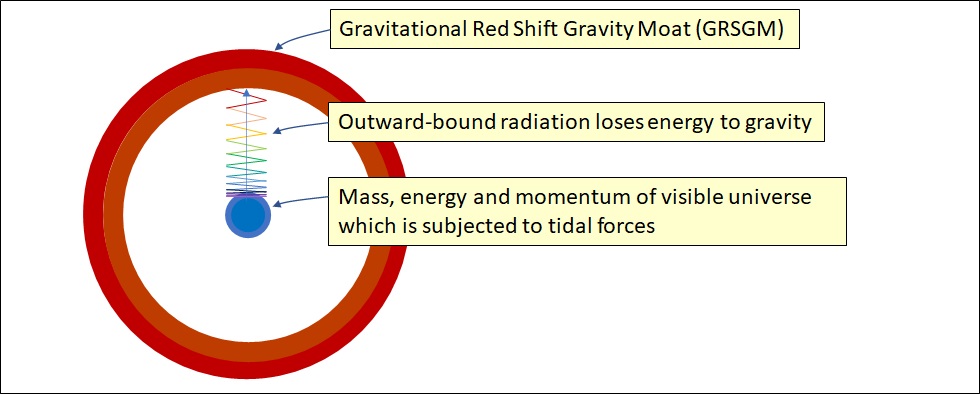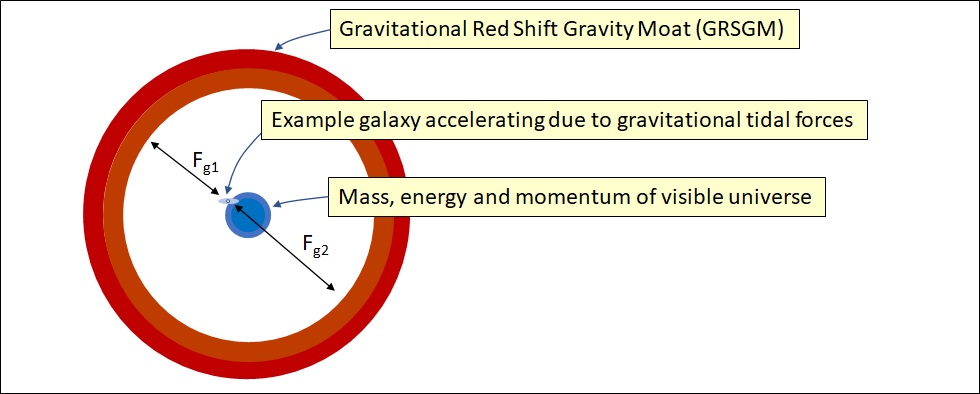Figure 2 shows the observable Universe and its environs as a closed system in which the radiated energy from the Big Bang, and subsequent accumulations in the following eons, loses energy and is red-shifted because of the drag arising from accelerating the matter, energy, and momentum in the observable Universe. All of these components affect the curvature of space-time and, therefore, all must be accounted for in a complete model.

Figure 2: GRSGM view is that as radiated energy travels away, it loses energy and slows in a manner similar to a black hole and the accreted photon sphere gravitationally affects the mass and energy in the visible Universe.
(Image by Wayne H. Coste, BS-EE, PE, IEEE-SM) Details DMCA
The energy contained in this sphere of radiated energy creates a gravitational attraction toward the interior boundary of this sphere and this, for lack of a better word, will be referred to as a gravity moat. This representation would then be a closed system - one that elastically links the inertial mass of the observable Universe to the radiated energy. The energy transferred to the acceleration of the inertial mass comes from reducing the energy in the outward-bound radiated energy. This reduction in radiated energy is manifested as a red-shift in the wavelength. This is because radiated energy with lower frequencies has less energy than radiated energy with higher frequencies. This elastic linkage of the inertial mass of the Universe with the gravity effects of the interior boundary of the sphere of radiated energy via red-shifting - consistent with Einstein's Equations - is referred to as the Gravitational Red Shift Gravity Moat (GRSGM) hypothesis.
The effect of the elastic linkage is to simultaneously do work on the radiating energy by red-shifting the radiation to lower, less energetic wavelengths while simultaneously doing work on the inertial mass in our Universe by accelerating it outward. Einstein's Equations provide a more general formulation of Newton's third law of motion: "For every action, there is an equal and opposite reaction". This effect provides the mechanism for gravitationally attracting galaxies and other mass in the observable Universe and accelerating them outward toward the GRSGM. Under this framework the Î"�CDM Concordance Model is transformed into the GRSGM-CDM Concordance Model by replacing the Cosmological Constant Î"� with a description of a physical property.
Figure 3 shows an example galaxy that is subject to the tidal forces of gravity that would draw the galaxy toward the moat (e.g., inner boundary) of the GRSGM. Due to this effect, any perturbed object that is off-center will be attracted more to the closer boundary of the GRSGM sphere than a more distant side. Under such a paradigm, the objects furthest out from the center will be drawn outward (e.g., accelerated) at a greater rate toward the GRSGM than objects closer to the center. Objects originating near the centroid may be subjected to smaller tidal forces and may be accelerated outward at slower rates. Under such a mechanism, all potential observers will see themselves moving away from each other in all directions.

Figure 3: Unequal gravitational forces (tidal) create an acceleration for all objects not at the absolute center of the sphere.
(Image by Wayne H. Coste, BS-EE, PE, IEEE-SM) Details DMCA
One of the key postulates for cosmologists is that the Universe is homogeneous and isotropic (e.g., the same everywhere) on the largest scales. The geometry and gradient of the tidal forces of the GRSGM hypothesis suggests that this may not be the case and incorporation of these GRSGM tidal forces into the Friedmann Equations would make them more complete.
Initial Conditions
Many explanations about the Big Bang use the analogy of an expanding gas cloud to illustrate the expansion and cooling of the ensuing hot, ionized fog. This seems to be a reasonable analogy for a significant fraction of the photons and particles during the period when they were in close enough contact that thermal "bumping" interactions were prevalent.
In such an environment the fog would expand and cool by the process where one particle, or quanta, bumps into another and accelerates it "outward," thus losing thermal energy in the process. Because these particles were estimated to be bumping into each other at velocities that were significant fractions of the speed of light, the outward expansion occurred very quickly. In this manner, the fog expanded in volume and the thermal energy of the interior particles was reduced (e.g., cooled). As the thermal pressure was reduced the expansion slowed because the time to travel between bumps increased and the impacting particles had less energy when they bumped. These particles, however, do not escape completely because they are forever bound together with all other particles, and quanta, by the gravity described in Einstein's Equation.
The expanding gas cloud analogy completely ignores the energy that would have been present that radiated away in all directions. Big Bang models estimate initial temperatures at t=0 that were in the range of 100 nonillion degrees (1032 degrees Kelvin). The radiated energy from this point of initiation would be beyond enormous and the radiated energy would not simply depart without an elastic effect on the remaining mass and energy. The radiated energy would become red-shifted due to the gravitational attractive effects of accelerating the "banging" matter and energy behind it - and the "banging" matter and energy would likewise be accelerated outward converting the energy transferred by the radiating energy into outward momentum. This would be additive to the net outward momentum from any thermal processes.
Cosmologists tend to emphasize that the Big Bang should be thought of the stretching of space itself rather than as a pressure driven "explosion". In the GRSGM hypothesis, the "stretching of space" is the elastic response of the remaining matter, momentum and energy to the expanding red-shifted radiation sphere. The supplemental concept of "space-itself" expanding - augmenting the outwardly driven boundary shell of radiated energy - does not seem to be necessary.
GRSGM Energy Balance
(Note: You can view every article as one long page if you sign up as an Advocate Member, or higher).




